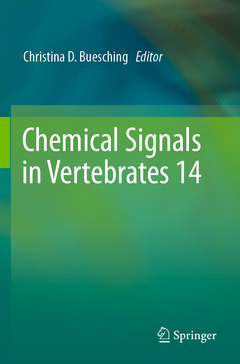Chemical Signals in Vertebrates 14, 1st ed. 2019
Coordonnateur : Buesching Christina D.

1. Perspectives on chemical signals conveying information in rodents.- 2. Latrines as potential communication centres in short-beaked echidnas.- 3. Do urinary volatiles carry communicative messages in Himalayan Snow leopards [Panthera uncia, (Schreber, 1775)]?.- 4. Encoded information within urine influences behavioural responses among European badgers (Meles meles).- 5. LPS-induced immune system stimulation alters urinary volatiles and behaviour in growing pigs.- 6. A field study of wild echidna responses to conspecific odour.- 7. How diet affects vertebrate semiochemistry.- 8. The social function of latrines: A hypothesis-driven research approach.- 9. The effects of artificial fragrances on human olfactory communication.- 10. The human mammary odour factor: Variability and regularities in sources and functions.- 11. Cross-cultural approaches to better understand chemical communication in humans.- 12. Adaptation of the University of Pennsylvania Smell Identification Test for the population of Central Russia.- 13. House Mouse (Mus musculus) Avoidance of Olfactory Cues from Ferrets and Other Mammalian and Reptilian Predators: Preliminary Results.- 14. Do carnivores have a world wide web of interspecific scent signals?.- 15. Chemistry between salamanders: Evolution of the SPF courtship pheromone system in Salamandridae.- 16. Comparative structural modelling of bovine vomeronasal type-1 receptor I (VN1R1) and elucidation of molecular interactions with pheromones using in silico approaches.- 17. Detecting the smell of disease and injury: scoping evolutionary and ecological implications.
Date de parution : 08-2020
Ouvrage de 260 p.
15.5x23.5 cm
Date de parution : 07-2019
Ouvrage de 260 p.
15.5x23.5 cm
Thèmes de Chemical Signals in Vertebrates 14 :
Mots-clés :
pheromone; olfactory communication; ethology; Ethology; Biochemistry; Animal behaviour; Model vertebrates



